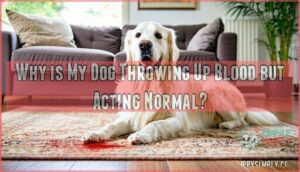This site is supported by our readers. We may earn a commission, at no cost to you, if you purchase through links.

This could mean anything from minor stomach irritation caused by eating something odd (because dogs will chew anything) to more serious issues like ulcers, infections, or even internal injuries.
Look for other symptoms like lethargy, loss of appetite, or frequent vomiting.
Avoid feeding your dog until you speak with your vet, who may need details like a photo of the vomit and a temperature reading.
It’s worth acting quickly—your furry friend’s health depends on it, and your vet can provide the necessary guidance to ensure the best outcome.
Table Of Contents
- Key Takeaways
- Examining The Vomit
- Understand The Possible Causes
- Visit Your Local Vet
- Steps to Take if Your Dog is Vomiting Blood
- Is a Dog Vomiting Blood an Emergency?
- Why is My Dog Throwing Up Blood but Acting Normal?
- What Will a Vet Do for a Dog Throwing Up Blood?
- Dog Vomiting Mucus? Here’s Why and What You Can Do About It
- Treating a Dog Vomiting Mucus
- How PetPlus Can Help
- Frequently Asked Questions (FAQs)
- Is a dog vomiting blood a cause for concern?
- What does blood in a dog’s vomit look like?
- Why is my dog vomiting specks of blood?
- What causes red specks in dog vomit?
- Why is my dog vomiting red blood?
- How do you know if a dog is vomiting?
- Why does my dog have red dots in his vomit?
- What causes flecks of blood in vomit?
- What if my dog has a small amount of blood in his vomit?
- Why does my dog throw up yellow bile with specks of blood?
- Conclusion
Key Takeaways
- Don’t feed your dog if you spot blood in their vomit, and contact your vet immediately for a proper diagnosis.
- Blood in vomit, whether fresh (bright red) or digested (dark, coffee-ground-like), signals possible issues like ulcers, toxins, or serious conditions needing urgent care.
- Take a photo of the vomit, note symptoms like lethargy or loss of appetite, and track any other changes to share with the vet.
- Prevent future problems by supervising your dog’s diet, avoiding toxin exposure, and scheduling regular vet checkups.
Examining The Vomit
Looking closely at your dog’s vomit might feel unpleasant, but it’s essential for understanding what’s happening.
Examining your dog’s vomit might be unpleasant, but it’s a crucial step in uncovering their health concerns and taking prompt action.
When you spot blood specks in dog vomit, the blood color tells an important story.
Bright red blood typically means fresh bleeding from the mouth, throat, or esophagus, while dark red or coffee-ground-like blood suggests it’s been partially digested in the stomach.
Pay attention to vomit consistency too.
Is it mostly liquid, thick, or foamy?
Volume significance matters—a few specks versus large amounts indicates different severity levels.
Frequency matters just as much; single episodes differ from repeated vomiting.
Note other contents in the dog vomit like food particles, bile, or foam.
Take a photo for your vet if possible.
This dog vomit analysis helps determine urgency and guides treatment decisions during your veterinary visit.
Understand The Possible Causes
When you notice blood specks in your dog’s vomit, you’re likely dealing with one of several underlying conditions that range from minor irritation to serious medical emergencies.
Understanding these potential causes, which include stomach ulcers, various medical conditions, and complications from parasites or foreign objects, will help you recognize when your pet needs immediate veterinary attention, due to possible serious medical emergencies or other complications that may require urgent care, such as immediate veterinary attention.
Stomach Ulcer
Despite their tough exterior, your dog’s stomach lining can develop painful ulcers when excess acid overwhelms the protective mechanisms.
These gastric wounds create an imbalance that leads to inflammation and bleeding, causing those concerning blood specks in dog vomit you’ve noticed.
Ulcer symptoms typically include:
- Reduced appetite and gradual weight loss over time
- Vomiting episodes that may contain blood or appear coffee-ground-like
- Lethargy and general discomfort during daily activities
- Changes in behavior such as reluctance to play or exercise
Ulcer diagnosis requires professional veterinary assessment using ultrasound or endoscopy to visualize the stomach lining. Common triggers include NSAIDs, liver disease, and chronic stress conditions like Addison’s disease.
Ulcer treatment focuses on reducing stomach acid production and addressing underlying causes. Proton pump inhibitors are often prescribed to reduce acid secretion. Most dogs recover within 2-4 weeks with proper medication. However, ulcer complications can develop if left untreated, making immediate veterinary care essential when you spot dog stomach bleeding.
Medical Conditions
Beyond stomach ulcers, various underlying diseases can trigger blood specks in dog vomit.
Liver and kidney disorders disrupt normal blood clotting, making your dog more prone to gastrointestinal bleeding.
Blood disorders like hemophilia prevent proper coagulation, while immune diseases attack your pet’s own blood vessels.
Systemic illnesses including pancreatitis and inflammatory bowel disease create widespread inflammation that damages delicate stomach tissue.
Toxin exposure from household cleaners or certain medications can also cause hematemesis in dogs.
These dog gastrointestinal issues require immediate veterinary attention because they often indicate serious health problems.
Your vet will run thorough blood tests to identify which condition is causing your dog’s stomach bleeding and develop an appropriate treatment plan.
Hemorrhagic gastroenteritis, or HGE may be present, causing raspberry jam-like diarrhea.
Parasites or Foreign Bodies
Discovering dog vomit specks of blood often points to parasites or foreign objects wreaking havoc inside your pup’s digestive system.
Intestinal parasites like hookworms and roundworms attach to the gut wall, causing irritation and bleeding when present in large numbers.
Dog parasites basically turn your pet’s intestines into their personal buffet, leaving behind damaged tissue that bleeds into vomit.
Foreign objects pose equally serious threats.
When dogs swallow toys, bones, or rocks, these items can scrape the esophagus or create foreign body obstruction.
Sharp objects cause immediate tissue damage, while blunt items may block the digestive tract entirely.
Key warning signs include:
- Persistent vomiting with blood specks
- Loss of appetite or lethargy
- Abdominal pain or bloating
Obstruction severity determines whether surgical removal becomes necessary.
Preventative measures like regular deworming and supervising playtime help protect your dog from both parasite types and foreign body risks.
Visit Your Local Vet
Specks of blood in your dog’s vomit signal it’s time for professional veterinary care. Don’t wait—schedule that vet appointment immediately when you notice dog vomit with blood specks.
Specks of blood in your dog’s vomit are a clear sign to act fast—schedule a vet visit without delay.
Here’s why visiting your local vet matters:
- Accurate Diagnosis – Your vet performs thorough examinations and tests to identify what’s causing the bleeding, from simple irritation to serious conditions requiring immediate attention.
- Targeted Treatment Plans – Professional veterinary care guarantees your dog receives appropriate medications, dietary modifications, or specialized procedures based on the specific diagnosis.
- Emergency Assessment – Some causes need urgent intervention, and your vet determines if emergency vet care or hospitalization is necessary for your dog’s safety.
Steps to Take if Your Dog is Vomiting Blood
When you discover blood in your dog’s vomit, your immediate response can make a significant difference in your pet’s outcome, so knowing the right steps helps you act quickly and effectively.
Taking prompt, organized action while staying calm allows you to provide your veterinarian with vital information and guarantees your dog receives the best possible care.
Stop Feeding
If your dog vomits and you spot specks of blood, don’t offer food just yet.
Withhold water temporarily but monitor symptoms closely. Once vomiting stops, introduce a bland diet in small portions, gradually increasing over time.
Avoid rushing back to regular meals too soon, as recovery takes patience. Follow veterinary advice carefully to guarantee your pup heals safely.
Blood in dog vomit isn’t ordinary—your dog deserves prompt, attentive care!
Call Your Vet Right Away
Once you’ve withheld food, immediately contact your veterinarian for urgent consultation.
Dog vomit blood signals serious conditions requiring emergency urgency and rapid action.
Even small specks of blood warrant prompt diagnosis from a dog emergency vet.
Don’t wait to see if symptoms improve—blood in dog vomit indicates potential internal bleeding, making this a dog vomiting blood emergency requiring immediate professional assessment and symptom severity evaluation.
Take The Dog’s Temperature
When taking temperature after spotting specks of blood in your dog’s vomit, use a digital rectal thermometer for accurate readings.
Insert it one inch deep for small dogs, 2-3 inches for larger breeds, after applying lubricant.
You can find a suitable thermometer online.
Normal range sits between 101°F-102.5°F, and temperature frequency monitoring helps your vet assess illness severity and track recovery progress effectively, which is a critical aspect of care.
Take a Photo of The Vomit and Blood for Your Vet
A clear photo of your dog’s vomit provides invaluable diagnostic aid for your veterinarian.
Capture the vomit photo details showing blood specks, color, and consistency before cleaning up.
This visual evidence helps with vet communication and supports accurate treatment guidance.
Your photo becomes a vital reference that assists the vet in determining the severity and potential causes of your dog vomiting blood.
Clean Up The Mess Quickly to Minimize Your Dog’s Exposure to It
After documenting the vomit, you’ll want to clean up quickly. Dogs often return to investigate their mess, which can worsen their condition or create additional health concerns.
- Protect your furry friend from re-ingesting harmful substances that caused the initial problem
- Keep your home safe for other pets and family members who might encounter contaminated areas
- Prevent bacterial growth that could complicate your dog’s recovery process
Use absorbent materials like paper towels to collect the vomit, then apply safe cleaning products to disinfect surfaces thoroughly. Consider using a specialized cleaner product for effective stain and odor removal. Proper disposal in sealed bags prevents your dog from accessing the mess again. These preventative measures help minimize exposure while you await veterinary care for specks of blood in dog vomit.
Is a Dog Vomiting Blood an Emergency?
Blood in your dog’s vomit, even tiny specks, signals a medical emergency requiring immediate veterinary care.
Don’t let normal behavior fool you – hematemesis in dogs indicates underlying issues that need urgent attention.
Blood amount doesn’t determine severity; even small traces suggest tissue damage in the digestive tract.
Delay risks include rapid progression of conditions like ulcers, poisoning, or internal bleeding, and a quick severity assessment by a veterinarian prevents complications.
When you spot blood in dog vomit, action urgency becomes your top priority for your pet’s safety.
Why is My Dog Throwing Up Blood but Acting Normal?
Your dog’s normal behavior doesn’t guarantee everything’s fine when you spot specks of blood in dog vomit.
Several underlying conditions can cause dog vomiting blood while maintaining regular activity levels, making diagnostic urgency even more important despite apparent wellness.
Here’s what might be happening behind the scenes:
- Minor gastrointestinal irritation – Small tears or inflammation may bleed without immediate distress
- Early-stage tumors – Growths can bleed intermittently before other symptoms appear
- Blood clotting disorders – Internal bleeding occurs without obvious behavioral changes
- Oral injuries – Gum damage creates blood that mixes with vomit
- Foreign object ingestion – Objects cause localized bleeding without systemic illness
Monitoring changes becomes critical since severity levels vary substantially among these dog health concerns.
If the vomit is accompanied by bloody stool, it could indicate hemorrhagic gastroenteritis (HG), a severe condition.
What Will a Vet Do for a Dog Throwing Up Blood?
Your veterinarian will start with diagnostic procedures including a thorough physical exam and blood work to assess organ function.
Diagnostic testing may involve X-rays, ultrasounds, or endoscopy to identify bleeding sources.
Treatment options depend on the underlying cause, but supportive care typically includes IV fluids and anti-nausea medication protocols.
Your vet might prescribe gastroprotectants to protect the stomach lining.
For some dogs, a severe case of hemorrhagic gastroenteritis could be the culprit.
Prompt veterinary care substantially improves outcomes for dog vomiting blood situations, and prognosis factors vary based on the severity and cause of your dog’s condition.
Dog Vomiting Mucus? Here’s Why and What You Can Do About It
When your dog vomits mucus with blood specks, you’re likely witnessing their digestive system’s response to irritation, dietary issues, or underlying health conditions.
Understanding the common causes, from simple dietary troubles to more serious gastrointestinal problems, helps you determine the appropriate response and when professional veterinary care becomes necessary, which is crucial for addressing the digestive system’s issues and making informed decisions about your dog’s health, including recognizing serious gastrointestinal problems.
Diet Troubles
Poor food choices often trigger specks of blood in dog vomit, especially when your pup has sensitive stomachs.
Food allergies can irritate the digestive tract, while dietary indiscretion—like raiding the trash—causes inflammation.
Sudden changes in dog food without gradual phases shock your dog’s system, and toxin ingestion from contaminated items creates serious problems.
Addressing these issues may require veterinary attention to rule out common pet issues.
Identifying problematic ingredients in your dog’s diet requires careful observation and systematic elimination of suspects.
- Monitor your dog food brand switches and ingredient changes closely
- Remove access to table scraps, treats, and garbage immediately
- Document everything your dog eats to spot patterns
- Implement dietary changes gradually over 7-10 days
Eating Something That Was Not Food
Curious pups often explore the world with their mouths, leading to foreign body ingestion that can cause specks of blood in dog vomit.
Whether it’s socks, toys, or rocks, these items irritate the digestive tract. Toxic Ingestion Signs include retching, drooling, and abdominal pain.
Dog endoscopy might be necessary for removal. Puppy Proofing Tips help prevent Dietary Indiscretion Risks, while Object Aversion Training addresses Pica Behavior Explained.
Never induce vomiting without veterinary guidance when foreign bodies are suspected.
Allergies
Food allergies can trigger your dog’s bloody vomit when their immune system overreacts to certain ingredients.
Environmental allergens like pollen or dust mites may also cause vomiting.
Watch for these allergy symptoms:
- Red, watery eyes and excessive scratching
- Skin rashes or hot spots appearing suddenly
- Vomiting episodes following meals or outdoor exposure
Allergy testing helps identify specific triggers, while allergy management through elimination diets and medication can prevent future bloody vomiting episodes in your dog, and this is crucial for prevention.
Gastrointestinal Problems
When your dog’s stomach becomes a battlefield, gastrointestinal issues like inflammatory bowel disease, acid reflux, or motility disorders can trigger specks of blood in dog vomit.
These gastrointestinal illness conditions disrupt the gut microbiome and cause malabsorption, leading to irritation throughout your dog’s stomach lining.
Contact your vet immediately for proper diagnosis and treatment.
Liver Disease and Pancreatitis
When your dog’s vomiting blood with mucus, liver disease and pancreatitis often work as a dangerous duo. These conditions cause internal bleeding through tissue damage and inflammation, leading to those alarming specks of blood in dog vomit.
Elevated liver enzymes and disrupted bile production signal trouble brewing inside.
- Abdominal pain that makes your dog reluctant to move
- Jaundice causing yellowing of gums and eyes
- Lethargy replacing your pup’s usual energy
- Fever indicating serious inflammation
Immediate veterinary care determines prognosis factors and establishes dietary management for recovery.
Treating a Dog Vomiting Mucus
When your dog’s vomit includes blood or red mucus, prompt care is key.
Treating dog vomit blood often involves Dietary Adjustments, carefully monitored Medication Options, and, if necessary, Hydration Therapy via IV fluids.
Here’s a quick breakdown:
| Treatment Option | Purpose |
|---|---|
| Dietary Adjustments | Eases stomach, promotes recovery |
| Medication Options | Reduces nausea, inflammation |
| Hydration Therapy | Prevents dehydration, stabilizes health |
| Probiotic Use | Supports gut healing, reduces GI upset |
For home care, offer small meals with bland foods and consult your vet asap.
You can find various options for dog anti-nausea products online.
How PetPlus Can Help
When your dog’s health takes a concerning turn, PetPlus is here to help with reliable, affordable solutions for hematemesis in dogs.
Here’s how:
- Veterinary Support: Get thorough exams to pinpoint causes of blood in dog vomit using in-clinic or telehealth access.
- Diagnostic Tools: We recommend imaging or bloodwork to uncover issues like tumors or ulcers.
- Treatment Savings: Access medication discounts, IV fluids, or surgery, paying less with PetPlus Savings!
- Preventative Care: Manage future problems through affordable prescriptions and personalized plans.
Consider regular veterinary care for early detection of health issues.
Your pup’s care, simplified.
Frequently Asked Questions (FAQs)
Is a dog vomiting blood a cause for concern?
Seeing blood in your dog’s vomit isn’t a minor hiccup—it’s a red flag.
Whether it’s a tiny speck or more, always consult your vet quickly.
Symptoms can hint at serious underlying health concerns.
What does blood in a dog’s vomit look like?
Blood in a dog’s vomit can look bright red, like fresh liquid, which often points to the esophagus.
Darker, clotted blood or a coffee-ground appearance suggests the stomach or upper intestines are involved.
Why is my dog vomiting specks of blood?
Tiny blood specks in vomit could mean irritation, minor digestive issues, or something serious, like ulcers or toxins.
It’s best to call your vet quickly—better safe than sorry regarding your pup’s health!
What causes red specks in dog vomit?
Red specks in vomit can mean irritation in the stomach, minor esophageal tears, or even ingested toxins.
It’s always best to consult a vet quickly, as even subtle signs might point to serious issues.
Why is my dog vomiting red blood?
Your dog’s vomiting red blood could signal anything from minor irritation in the esophagus to more serious issues like ulcers, infections, or toxins.
It’s best to consult your vet immediately to determine the cause.
How do you know if a dog is vomiting?
You’ll notice your dog vomiting through signs like retching, heaving, or gagging just before expelling.
They might look uncomfortable, drool excessively, or eat less.
It’s unmistakable when they start leaving surprises on your carpet, and this can be a clear indication of their discomfort, making it a key moment to take action.
Why does my dog have red dots in his vomit?
Blood in your dog’s vomit can signal anything from minor irritation to a serious issue like ulcers or infections.
Monitor for other symptoms, stay calm, and contact your vet to guarantee your furry friend’s safety.
What causes flecks of blood in vomit?
Flecks of blood in vomit can result from irritated stomach lining, swallowing blood from a cut mouth, or minor throat injuries.
However, it might signal serious issues like ulcers, infections, or toxins—always consult your vet promptly.
What if my dog has a small amount of blood in his vomit?
Seeing a little blood in your dog’s vomit can be unsettling, but it’s not always a crisis.
Watch for symptoms like lethargy or worsening vomiting, and call your vet to rule out serious issues.
Why does my dog throw up yellow bile with specks of blood?
Yellow bile with specks of blood often points to an irritated stomach or esophagus, possibly from repeated vomiting, ulcers, or toxins.
A vet visit is essential to pinpoint the cause and prevent worsening issues.
Conclusion
Spotting specks of blood in dog vomit can seem scary, but swift steps safeguard your pup’s health.
Symptoms like lethargy or loss of appetite signal concern, so stay sharp and seek professional advice promptly.
Avoid feeding, take note of changes, and provide your vet with details like a vomit photo or temperature reading.
While minor irritations might resolve quickly, serious issues need timely care, always prioritize their well-being—your vet’s guidance will help keep tails wagging with swift steps.

















